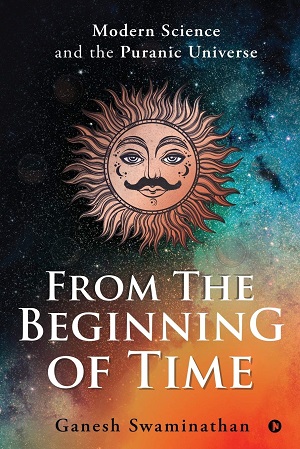From the beginning of Time looks at the cosmology as mentioned in Purana – Indian scriptures that talk about virtually everything under the sun. As my lockdown project, I have been studying astrology and that took me to the planets in the sky. During this time, I heard the author speak about the cycle of Sun, precisely what I was reading in Brahmand Puran at that moment. So, this was a book to be read.
 The book primarily looks at the cosmic bodies as well as the potential cosmic events as they are known to us from modern scientific evidence. It then corroborates the parts of different Puranas that point to the same events though wrapped in the stories of the deities. While I was reading bits and pieces in different Puranas, this book helped me see them as one single narrative.
The book primarily looks at the cosmic bodies as well as the potential cosmic events as they are known to us from modern scientific evidence. It then corroborates the parts of different Puranas that point to the same events though wrapped in the stories of the deities. While I was reading bits and pieces in different Puranas, this book helped me see them as one single narrative.
It talks about the lifecycle of the Sun and how our timelines defined with terms like Brahma’s day and Manvantaras actually define different stages of the Sun. Sun is essentially a star that takes birth, reaches a mature stage where it nurtures a planetary system around it. It dies at the end of its life when the planets drift away from it. These planets may find another star or they may get lost in the galaxies.
Buy From the Beginning of Time by Ganesh Swaminathan at Amazon
The journey of the moon as explained in this book is fascinating. We all know the stories of the moon, it’s siring a son with Tara, its emergence from the ocean during Sagar Manthan, or the curse that makes it wax and wane. The author beautifully connects all these stories and presents the cosmic events that they tell. Life on earth can not be sustained without the moon is something that we always knew but now science is also reaching the same inference. The chapter on earth takes you through different layers outside and inside the earth.
Read More – The Greatness Of Saturn By Dr. Robert E Svoboda
Story of Ganga’s Waters
The story of Ganga’s waters coming from the outer world was eye-opening. However, my question is – Is this only the water of the river that we call Ganga or it is all the water in all the rivers? Remember, in many parts of Asia, the word for river is Ganga. Even in India, many rivers are called Ganga in their alternative names. The story of great floods from the beginning of time is common across cultures. Ganesh has picked up the nuances of the various versions of the story mentioned in different Puranas to explain the sustenance of life over Kalpas or during the age of dissolution.
Read More – Brahma Gyan – Science Behind Shiva by Ravikumar Kakde
Cosmology
Overall, the book helps you understand cosmology as it is told in our ancient scriptures. It also gives you a handle on how to interpret the Puranic stories, which are far more than mere stories or some fancy imagination. It helps you understand the world of Indian Puranas and the author of all these Ved Vyasa. Most importantly, it highlights the need to read and interpret our ancient texts to understand what they already knew. There is a lot of hidden knowledge that we have not tapped into and hence not used it.
Read More – India A Sacred Geography by Diana L Eck
Sagar Manthan
Most Indians would have heard stories like Sagar Manthan or Churning of the Oceans, or descend of Ganga on earth. To interpret them from a scientific angle that tells us the key events of our universe’s past is enriching. There are ample verses given to the reader to read them directly. I realize that Brahmand Puran which essentially refers to the cosmic egg or the universe to the extent we know it is the most comprehensive text on understanding the outer world. Happy that I am currently reading it.
Read More – The Lost River On the Trail of the Sarasvati by Michel Danino
The language used is simple. The narrative is written with a layperson in mind, who understands the basics of science as we know it today and probably does not know much of Puranas. Even those without a grounding in either science or Puranas would easily understand the book.
Read More – Indian Culture and India’s Future by Michel Danino
Puranas English Translation
I believe the author read all the Puranas in English translation. So there is sometimes an error in understanding certain words. Like, he interprets Vasundhara and the flow of Vase assumes Dhara is flow. While when you read in Hindi or Sanskrit, it is dhra which means the one who bears. Barring these couple of instances, everything else flows pretty smoothly. I think the chapter flow explained at the beginning of each chapter could have been avoided. Explaining it once would have sufficed. As almost all chapters follow the same pattern. Similarly, chapters are not too long. So a summary at the end was not needed. The summary of all the events at the end of the book is great. It helps you see everything as part of one big narrative.
Read More – What We Cannot Know by Marcus Du Sautoy
If you want to understand the science in Indian scriptures or the night sky fascinates you, pick up From the Beginning of Time: Modern Science and the Puranic Universe.








